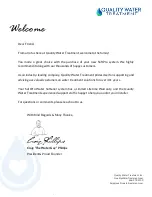
65
TANK
CLEANOUT
OPENING
CLEANOUT
COVER
CLEANOUT
GASKET
CLEANOUT
ACCESS PANEL
figure 63
manual lime scale remoVal
note:
Contact your local distributor or call the parts department
phone number on the back cover of this manual to order a new
cleanout gasket. Have the new gasket available before removing
the cleanout cover.
The cleanout opening is shown in Figure 63. To remove lime
scale manually through the cleanout opening proceed as follows:
1. Turn off the electrical supply to the water heater.
2. The water heater must be drained, see Draining And Flushing
on page 64, follow the instructions on how to drain the water
heater.
3. remove outer cleanout access plate from lower side of the
water heater jacket.
4. remove the cleanout cover from cleanout opening.
5. remove lime, scale and/or sediment using care not to
damage the glass-lining.
6. Install a new cleanout gasket if required.
7. reinstall the cleanout cover. Be sure to draw plate up tight
by tightening screws securely.
8. Close the water heater drain valve.
9. Fill the water heater - see Filling The Water Heater on page 52.
10. Turn on the electrical supply to place the water heater back
in operation. See Initial Start Up on page 52.
11. Allow the water heater to complete several heating cycles to
ensure it is operating properly.
12. Check for water leakage.
13. reinstall the cleanout access plate.
chemical lime scale remoVal
To dissolve and remove more stubborn lime scale deposits, UN-
LImE® Professional Delimer should be used.
UN-LImE® Professional Delimer is an easy to handle patented
food grade acid formulated specifically for lime scale removal
from all types of water using equipment. Hydrochloric base acids
must not be used to delime the water heaters covered in this
manual.
Follow the instructions on the UN-LImE® to delime the water
heater.
note:
Call the parts department phone number on the back
cover of this manual to order UN-LImE® Professional Delimer.
See TABLE 15 on page 66 for part numbers.
5. Ensure the drain hose is secured before and during the entire
flushing procedure. Flushing is performed with system water
pressure applied to the water heater.
6. Open the water heater drain valve to flush the storage tank.
7. Flush the water heater storage tank to remove sediment and
allow the water to flow until it runs clean.
8. Close the water heater drain valve when flushing is completed.
9. remove the drain hose.
10. Fill the water heater - see Filling The Water Heater on page 52.
11. Turn on the electrical supply to place the water heater back
in operation. See Initial Start Up on page 52.
12. Allow the water heater to complete several heating cycles to
ensure it is operating properly.
filling the water heater
See Filling The Water Heater on page 52.
sediment remoVal
Waterborne impurities consist of the particles of soil and sand
which settle out and form a layer of sediment on the bottom of
the tank.
For convenience, sediment removal and lime scale removal
should be performed at the same time.
lime scale remoVal
When water is heated dissolved minerals in the water such as
calcium and magnesium carbonate (lime scale) become less
soluble. As the water temperature rises these minerals will
precipitate or “fall out” of solution.
The amount of lime scale released from water is in direct
proportion to water temperature and usage. The higher the water
temperature or water usage, the more lime deposits are dropped
out of the water.
Water hardness also affects lime scale accumulation. With the
temperature and usage being the same, hard water will release
more lime scale than softer water.
Lime scale reduces heating efficiency as it accumulates inside
a water heater. Heating transfer surfaces become coated with
lime scale deposits which increases fuel costs to operate the
water heater. Lime scale deposits can also cause rumbling
and pounding noises as air molecules trapped in the lime scale
escape when heated. Lime scale accumulation also reduces the
life span of water heaters. For these reasons a regular schedule
for deliming should be set up.
The depth of lime accumulation in the bottom of the water
heater should be measured periodically. Inspect by removing
the cleanout cover once every 6 months at first. Deliming
maintenance should then be performed based on the time it
takes for 1 inch (2.5 cm) of lime to accumulate in the bottom of
the water heater.
Sediment and lime scale removal may be accomplished manually
through the cleanout opening furnished on the water heater, see
Figure 63.
















































